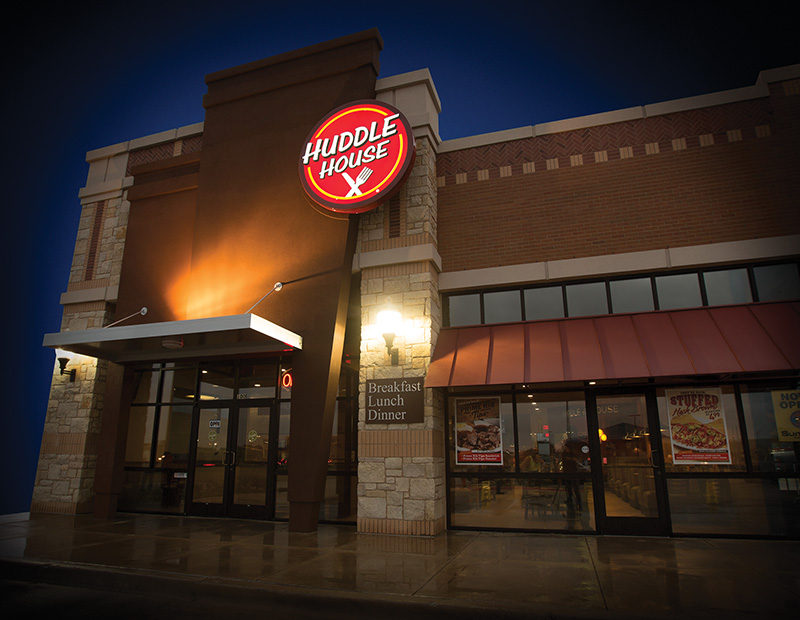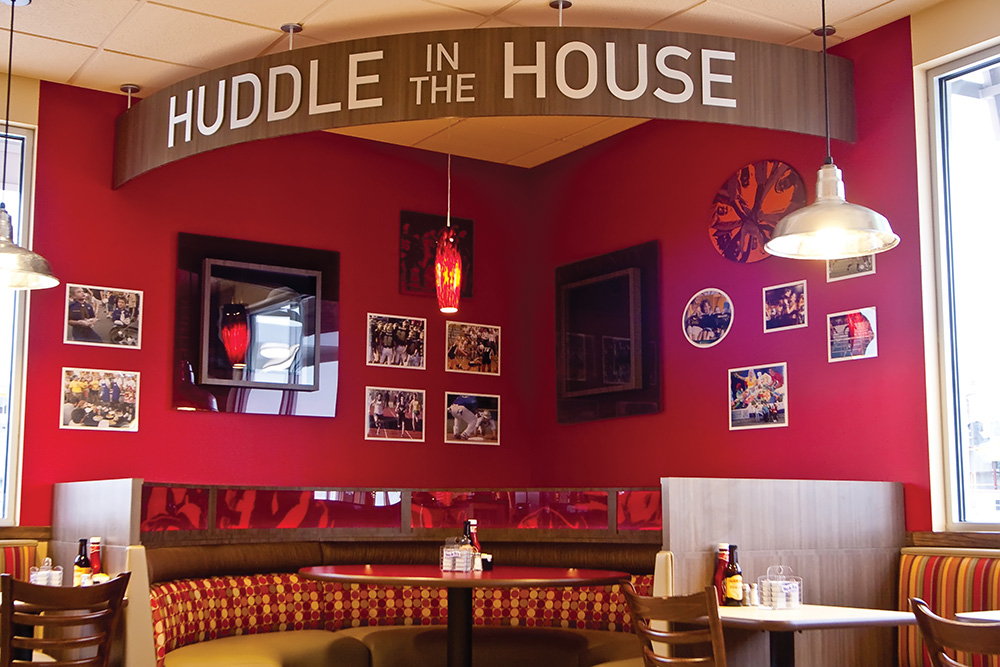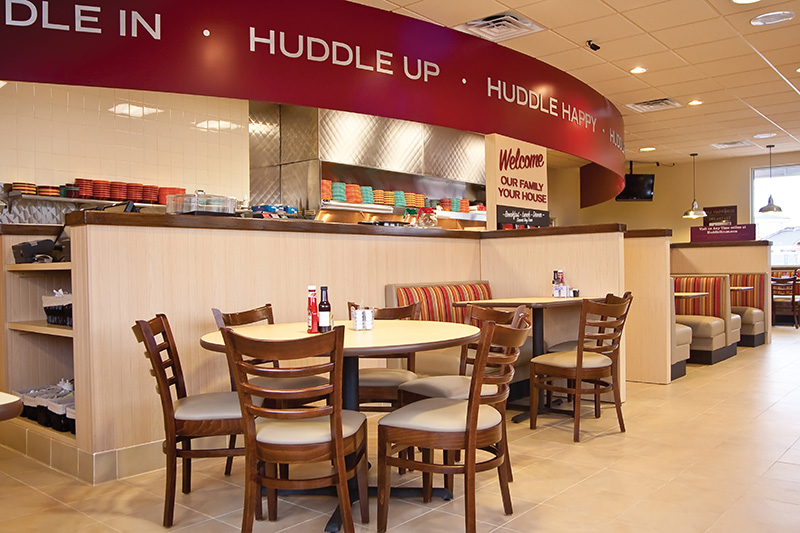As Huddle House marks its 50th anniversary, the company is rallying its franchise teammates to keep improving the efficiency and operations — starting with a brand new prototype design.
By Katie Lee
In 2014, Atlanta-based Huddle House marked 50 years of serving homestyle comfort food at a value price point. Any restaurant company worth its salt doesn’t reach that milestone without mastering the art of evolution — evolving with the times through updated menu offerings, an overall new look, and more efficient operations. At Huddle House, ‘Evolution’ also happens to be the name of its new prototype design.
 The refreshed Evolution design, which was first introduced in 2013, features a signature tall tower entrance that draws the eye upward, new signage and awnings, warm colors, contemporary furniture including upholstered booth seating, and vibrant lighting. By the end of 2014, 30% of the franchise system was on track to have the new look; Huddle House aims to remodel all remaining locations with the new design by 2019. According to Jonathan Benjamin, chief development officer, restaurants with the new design have been experiencing a double-digit increase in sales and transactions years over year.
The refreshed Evolution design, which was first introduced in 2013, features a signature tall tower entrance that draws the eye upward, new signage and awnings, warm colors, contemporary furniture including upholstered booth seating, and vibrant lighting. By the end of 2014, 30% of the franchise system was on track to have the new look; Huddle House aims to remodel all remaining locations with the new design by 2019. According to Jonathan Benjamin, chief development officer, restaurants with the new design have been experiencing a double-digit increase in sales and transactions years over year.
Coinciding with Huddle House’s 50th anniversary and the new Evolution design is renewed interest in growing the brand. In 2014, the full-service franchise — which has 387 restaurants in 21 states — closed eight new deals that brought 15 additional restaurants to Georgia, Illinois, New York, Texas and Virginia. In 2015, the company plans to open 20 new restaurants while continuing to remodel and reopen existing locations.
While much of the credit for Huddle House’s recent resurgence is being given to its refreshed design, behind the scenes of that new look is the Operations team, which had a significant say in improving overall efficiency.
 “It’s a great design with the input of the Operations team,” says Brian Kendrick, senior director of design and construction. “A lot of it was trying to come up with a more efficient cook line — taking out some equipment and bringing in new equipment and positioning things where they need to be so the cooks and staff don’t have to take as many steps to go from one place to another. They try to find ways to be efficient in the space — and utilize every cubic foot of space in the front of house and back of house for storage to make it as useful as possible.”
“It’s a great design with the input of the Operations team,” says Brian Kendrick, senior director of design and construction. “A lot of it was trying to come up with a more efficient cook line — taking out some equipment and bringing in new equipment and positioning things where they need to be so the cooks and staff don’t have to take as many steps to go from one place to another. They try to find ways to be efficient in the space — and utilize every cubic foot of space in the front of house and back of house for storage to make it as useful as possible.”
Typically, the new freestanding restaurants are 2,400 to 2,500 square feet with the smallest size clocking in at 2,250 square feet. In an age when many restaurant companies are looking to do more with less, the new Huddle House footprints are noticeably larger than their predecessors; most of the older restaurants were 2,000 square feet or less.
“We saw that by increasing the seat count, it was a better option for franchise partners and in increasing the building size, we still try to be real efficient with it,” says Kendrick. “There’s really not any wasted space. If you look at our older buildings compared to our newer buildings, the new buildings are much more efficient per square foot than they were in the past.”
Part of Huddle House’s newfound efficiency can be attributed to its investment in LED lighting systemwide. Cree, Inc., a leading innovator of LED lighting and semiconductor solutions, has been working with Huddle House on its goal to increase efficiency while also lowering its overall operational costs.
“Cree Lighting is one of the leaders in LED technology,” Kendrick says. “They’ve been a huge help. They do a lot of work with McDonald’s, so we’re able to piggyback on a lot of the initiatives that they implement at McDonald’s.”
 According to Kendrick, Huddle House has been working with Cree to bring lighting costs down. “Being a 24-hour restaurant, all of our lights are on all day and all night, so it makes a lot of sense,” he says. “Now we can replace all of our back-of-house lighting very inexpensively compared to the past. There’s a 13-month payback on that, so most franchisees, when they see that, it’s really a no-brainer. They cost a little more up front, but in the end, they’re going to recoup that and more.”
According to Kendrick, Huddle House has been working with Cree to bring lighting costs down. “Being a 24-hour restaurant, all of our lights are on all day and all night, so it makes a lot of sense,” he says. “Now we can replace all of our back-of-house lighting very inexpensively compared to the past. There’s a 13-month payback on that, so most franchisees, when they see that, it’s really a no-brainer. They cost a little more up front, but in the end, they’re going to recoup that and more.”
The fact that LED is better for the environment, too, is icing on the cake. “It’s a balance between finding the right products for the application and finding a product that has some ‘green’ aspects to it,” Kendrick adds. “Any time you can get both, that’s a win-win.”
Down the road, Huddle House plans to continue its tradition of innovation and evolution — challenging all departments to find ways in which they can improve. “We’re constantly looking at aspects of the brand [such as] kitchen equipment, design or finishes,” Kendrick says. “We’re always looking at ways in which we can improve on what we do, even if it doesn’t mean changing the overall look of the brand. If we can find ways to better operate the brand and help bring those development costs down, it makes a better option for franchise partners. In the near future, that’s a big part of it: keep trying to improve, inside and out.”
[NOTE: This article originally appeared as the cover story of the December 2014/January 2015 issue of Restaurant Facility Business magazine. Email the editor at [email protected].]
